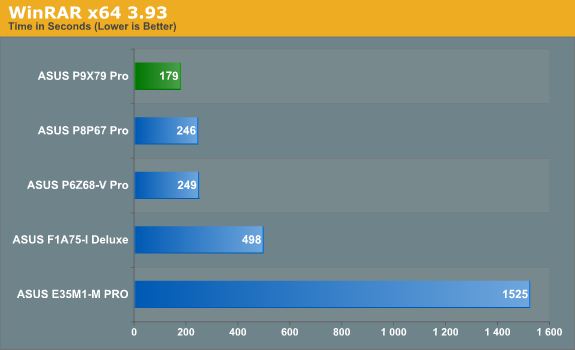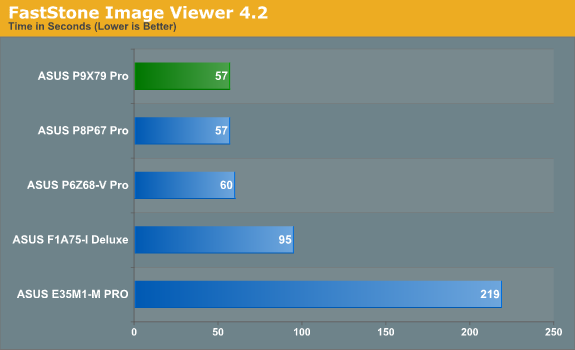Sandy Bridge-E and X79 – The ASUS P9X79 PRO Review
by Ian Cutress on November 14, 2011 3:01 AM EST- Posted in
- Motherboards
- Asus
- X79
3D Movement Algorithm Test
The algorithms in 3DPM employ both uniform random number generation or normal distribution random number generation, and vary in various amounts of trigonometric operations, conditional statements, generation and rejection, fused operations, etc. The benchmark runs through six algorithms for a specified number of particles and steps, and calculates the speed of each algorithm, then sums them all for a final score. This is an example of a real world situation that a computational scientist may find themselves in, rather than a pure synthetic benchmark. The benchmark is also parallel between particles simulated, and we test the single thread performance as well as the multi-threaded performance.


As expected, due to the 3960X, we have a clear lead on 3DPM. In single thread mode, we have a 3.9 GHz core taking top place, and the power of 12 threads at 3.6 GHz in multithreaded mode shows in the 914.76 score.
WinRAR x64 3.93 - link
With 64-bit WinRAR, we compress the set of files used in the USB speed tests. WinRAR x64 3.93 attempts to use multithreading when possible.

The more cores and threads for WinRar also play a role in providing some excellent times in comparison to other chipsets.
FastStone Image Viewer 4.2 - link
FastStone Image Viewer is a free piece of software I have been using for quite a few years now. It allows quick viewing of flat images, as well as resizing, changing color depth, adding simple text or simple filters. It also has a bulk image conversion tool, which we use here. The software currently operates only in single-thread mode, which should change in later versions of the software. For this test, we convert a series of 170 files, of various resolutions, dimensions and types (of a total size of 163MB), all to the .gif format of 640x480 dimensions.

In this single threaded workload, no real difference is seen compared to P67, showing that for FastStone, memory is not a limiting factor, and the move to SB-E doesn't make much of a difference.
Sorenson Squeeze 6.0 - link
Sorenson Squeeze is a professional video encoder, complete with a vast array of options. For this test, we convert 32 HD videos, each a minute long and approximately 42 MB in size, to WMV 512KBps format. Squeeze can encode multiple videos at once, one for each thread.

With Squeeze being a fully multithreaded test, we're comparing a 4 thread i5-2500K to a 12 thread 3960X, so it's no wonder that the 3960X comes out on top.










55 Comments
View All Comments
RegGam - Monday, November 14, 2011 - link
SSD caching looks like a killer feature. It seems like it's the key new feature this year. But, I am surprised that ASUS chose not to use Intel SRT. Any idea why? Or, is this a rebranded solution from NVELO?Also, I don't get why the "SSD Cache" ports are 3Gb/s SATA. All the new SSDs will be 6Gb/s so shouldn't the 6Gb/s ports be dedicated to caching? Or, let me choose!
ASUSTechMKT - Monday, November 14, 2011 - link
SRT is not supported natively on the PCH for X79 as such we phased in our ASUS SSD Caching implementation. To clarify the SATA controller used does offer SATA6G support.RegGam - Monday, November 14, 2011 - link
That's great news. (article should be updated). So, I can use any SSD with any SATA 3G or 6G port. So, when can we see a comparison of intel SRT against this solution? And, if it's not Dataplez, compare against that too.Also, when will this be available in Europe (France)?
RegGam - Monday, November 14, 2011 - link
Aww sh!t, just looked at the snapshots. It's a Marvell controller feature. If its the same as their hyperduo junk, I'm no longer interested. Thats not even real caching, just concatenation. I was so excited too. :-(ASUSTechMKT - Wednesday, November 16, 2011 - link
Actually it is the same as SRT which and in realworld performance compairson you acheive the same improved results ( reduced boot times, significantly faster read performance, imporved application response. There is also the advantage compared to SRT that you are no limited on the cache volume size.Overall it is a solid implementation and the cool part is you can still locally run a primary volume and then have your secodary volume ( storage be cached.
mailman65er - Friday, November 18, 2011 - link
> Actually it is the same as SRTHardly... that so-called "caching" feature based on the Marvell (I think they call it hyber duo), does not even perform real caching - its already been exposed. junk... fail...
use SRT or dataplex...
CodeToad - Friday, December 2, 2011 - link
I think you are incorrect on this. Yes, there are two Marvell ports stated to run at 6G. Like you I'd never use that. But there are two 6G ports available on the main, and not Marvell.chrone - Monday, November 14, 2011 - link
with that hefty price, i wonder no dual LAN teaming support. :PASUSTechMKT - Wednesday, November 16, 2011 - link
Cost we phased in a number of more readily useable options than dual lan ( which is only used by a very small % ( of course we do have it on two other boards Deluxe and WS which even features dual Intel lan ).Keep in mind things like 6 pwm fan headers with advanced control for 5 of those headers means a higher bom cost to put the header , the super I/O controller and other aspects little items like this all add up and you have to make the calls on what to phase in over what not to.
wharris1 - Monday, November 14, 2011 - link
I wonder why the 2600 was not used as a comparison CPU for the multithreaded benchmarks in lieu of the 2500.